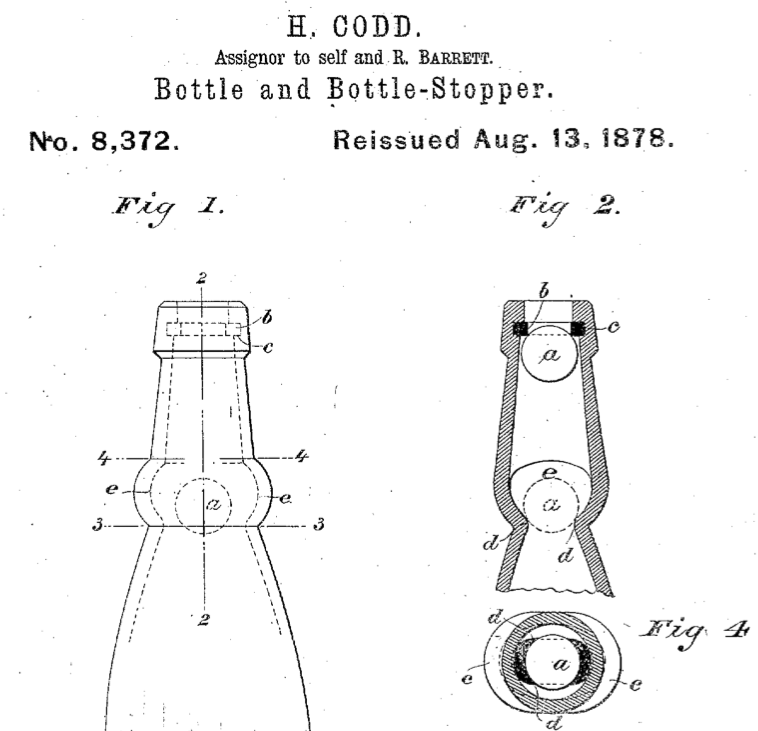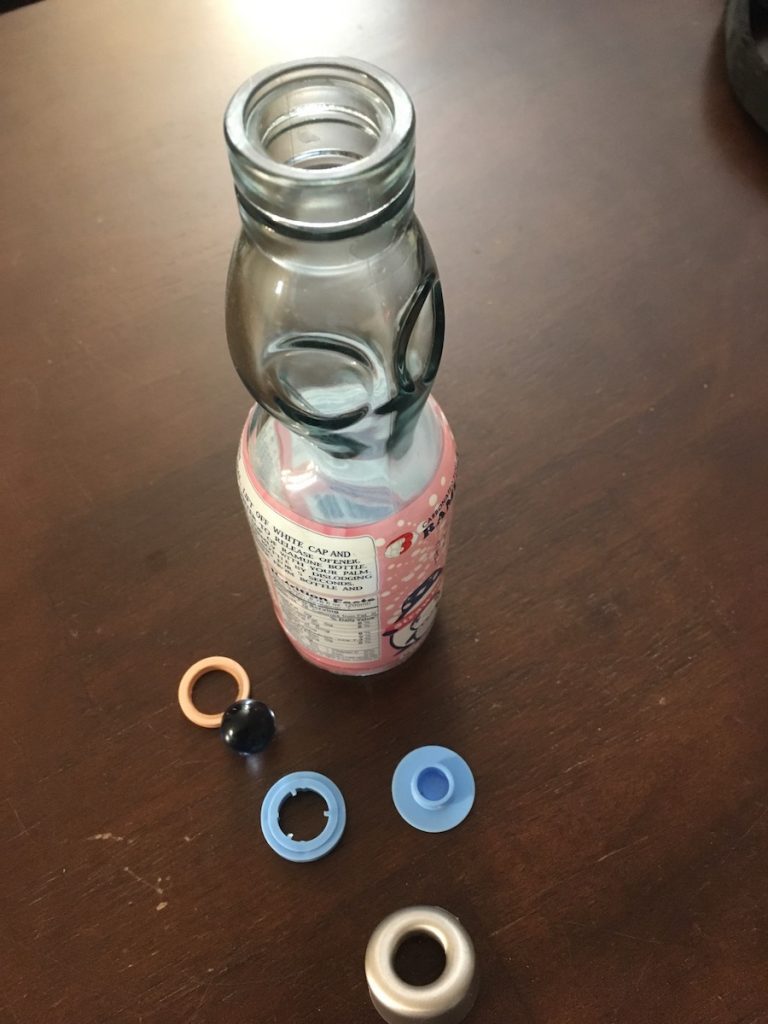The patent office tells us that the Codd stopper was invented by Hiram Codd in the 1800s. It soon became the closure of choice for the burgeoning soda water market. Yes, even in the mid-1800s, people were buying bottled water. But this was carbonated spring water, thought to be much more healthful than the surface and well waters of the time. Considering the state of sanitation practices, it probably was.
Ordinary corks, which live on only in wine bottles today, were not able to retain the pressure of high carbonation. Enter Hiram Codd. By means of a carefully crafted neck, a rubber gasket, and an imprisoned marble, even the most effervescent spring could have its waters bottled for mass consumption.

The Codd closure employs a very simple concept, as Codd himself explains above: The pressurized head space of an effervescent water or soda, exerting pressure against a marble, forces the marble “a” to seal the bottle against rubber gasket “b”.
At the bottling works, filling the bottle is a bit less intuitive, because the marble has to be encouraged to travel up to the gasket where it can be retained by gas pressure. To do this, the Codd bottle is inverted; the fizzing water is filled by means of an inserted filler tube; the tube is removed; and when the bottle is righted, the pressure of the carbonation forces the imprisoned marble against the (interior) rubber gasket, sealing the bottle.
At home, to open the seal, the marble is pushed down forcefully, using any instrument you may have at hand. The pressure is released with a dramatic gush, the marble comes to rest in a pocket in the neck, and the beverage may now be poured. All of this requires a carbonated beverage. Flat beverages cannot be sealed with a Codd closure.
For all its genius, the Codd closure fell out of favor and dropped completely out of sight well before 1900, as other means such as the Hutchinson stopper and the crown cap (which survives on beer bottles today) showed themselves to be as effective and much cheaper.
Yet, inexplicably, the traveler to Japan or certain parts of India will find the Codd stopper alive and well, firmly entrenched in an obscure niche market — certain types of flavored sodas.
Japan
Visitors to Japan, particularly if there is a festival going on nearby, will recognize the Codd closure in the Ramune bottle. Ramune (pronounced RA-moo-nay) is a class of soda beverage made by several manufacturers, and recognized nostalgically as a staple of childhood summers. Ramune was traditionally a lemon-flavored soda. In later years, a host of bizarre flavors have emerged. But again, the bottle is the key. The lovely gush of gas and moisture continues to say “summer” to many people across Japan.



India
In India, visitors to Delhi will find a homemade beverage known as Banta sold on many street corners in a Codd bottle. It is a fizzy carbonated lemon-flavored drink (again) that has been the unofficial drink of Delhi for longer than anyone can personally remember. According to one vendor, “no one will buy the drink if we change the bottle.”
So here we see that sometimes, the integrity of a product can be carried as much by the integrity of its package as by the integrity of its contents. Today, the prevailing conventional wisdom among mass-market producers tends to assume that it is only the contents that matter, and the package is arbitrary, free to be changed to whatever suits the manufacturer. The error is that the customer’s experience can be strongly rooted in both. The tendency to accept such a change might vary by culture and by product. It is easy to see that where the product and the package combine to create an overall experience, there might be some resistance to a change in either.
Interestingly, the Ramune bottle also inherits one more archaic feature of sodas of the 1800s… the serving size. Coca-Cola and many other soft drinks of the late 1800s were originally sold in 6.5-ounce bottles (until the mid-20th century when competitors such as Pepsi-Cola offered 12-ounce servings). The metricized Ramune bottle is 200 ml, or 6.76 ounces.
By forking off when they did, Ramune and Banta have thus avoided not only today’s prosaically efficient methods of bottling and closure, but also the gargantuan portion sizes that contribute to soda-obesity today.
Article and photos Copyright 2022.
To subscribe to new posts, visit https://whatshallweweird.com/subscribe/


